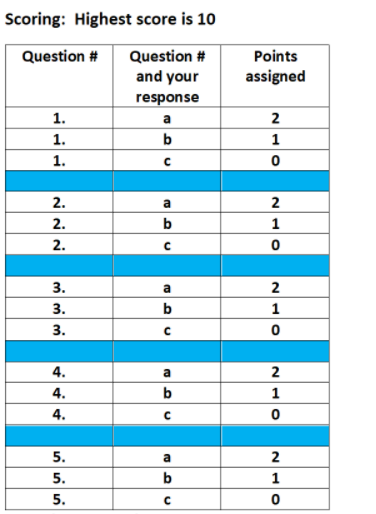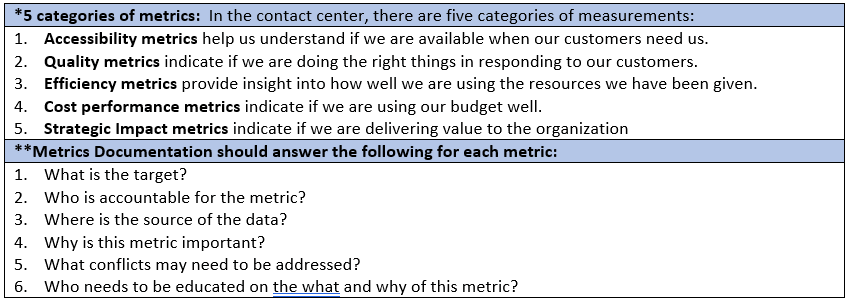By
Rose Polchin
|
Date Published: June 01, 2021 - Last Updated June 03, 2021
|
Comments
Delivering exceptional customer service is one of the keys to an organization’s success and contact centers are one of the primary ways this can be achieved. Memorable customer experiences drive loyalty and create individuals who also promote our company to others. Beyond creating loyal customers, contact centers can also deliver value in other ways such as: ensuring that they are operating in a cost-efficient manner and capturing, analyzing and sharing data on customer insights, process opportunities, training needs etc., with the entire organization to help deliver on the mission and ensure continuous improvement.
The question is, how do we measure how well the contact center is delivering these different levels of value to the organization? That’s where metrics come into play. Metrics allow us to assess the performance of the contact center and allow us to track progress towards goals. The key is to choose the right metrics.
Metrics assessment: The following is a “quiz” with 5 questions designed to assist you in either selecting the right metrics and/or assessing your current ones. The goal is to ensure that your metrics allow you to assess how well your center is meeting the needs of the organization, the customer, and your employees to not only ensure we are delivering value but also communicating it to others.
Take out your current contact center metrics and ask:
1. Are your metrics aligned with the company’s mission, goals, and values?
a. 95-100% of our metrics are aligned with our mission, goals, and values.
b. 50-94% of our metrics are aligned with our mission, goals, and values.
c. Less than 50% of our metrics are aligned with our mission, goals, and values.
2. Do you have metrics that allow the contact center to assess the contact center’s performance in the areas of accessibility, efficiency, quality, cost performance and strategic value*?
a. We have metrics in each of the 5 categories.
b. We have metrics in 3-4 of the 5 categories.
c. We have metrics in 1-2 of the 5 categories.
3. Do you have a document** that clearly defines and communicates the following for each metric?
a. We have a comprehensive metrics guide that has been communicated to all employees.
b. We have metrics for different groups. Some are documented and defined completely, while others are not.
c. We have metrics but they are not defined or documented very well.
4. Are your metrics interrelated and drive behavior?
a. We consistently review our metrics to identify and manage any conflicts that may occur. (i.e. AHT and Quality)
b. We periodically review our metrics for conflicts, but rarely change them even if they conflict or drive inconsistent behaviors.
c. We aren’t analyzing the relationship between various metrics.
5. Metrics should be S.M.A.R.T. Specific, measurable, achievable, relevant, time oriented.
a. 95-100% of our metrics are S.M.A.R.T.
b. 75-94% of our metrics are S.M.A.R.T.
c. Less than 75% of our metrics are S.M.A.R.T.
Score interpretation:
7-10: Metrics Mavens
You have a balanced approach to metrics. They are aligned with the mission, vision and values of the organization, are well documented and communicated, and consistently reviewed to identify potential conflicts and undesirable consequences. The interrelated nature of metrics is understood and metrics are analyzed, reviewed and updated as necessary. Your metrics allow you to track operating costs, business needs, assess customer and employee experiences and opportunities to improve efficiencies.
4-6: Heading in the right direction
There are metrics that allow the contact center to assess the contact center’s performance in 3-4 of the 5 recommended areas (efficiency, quality, cost performance and strategic value.) This means there is an opportunity to achieve a more holistic, balanced view of performance by ensuring metrics exist for each of the 5 areas. Tracking and reporting performance consistently is a step in the right direction, however, to be meaningful, metrics need to be used to identify and implement improvement opportunities. Documenting, defining and communicating all of your metrics will increase buy-in at all levels and highlight any potential conflicts between metrics. Periodically reviewing your metrics is essential and should be done not just once a year, but also when business or economic conditions change.
0-3: In need of a course correction
This is a great opportunity to revisit and revise your metrics to ensure they track and measure contact center performance in a more holistic manner. The metrics (and corresponding targets) should enable the center to identify whether they are meeting the needs of the business, the customer and employee, not just one or two of these stakeholders. It is not enough to just measure customer experience, contact centers need to ensure that they are doing so in a cost-effective, efficient manner. The employee experience has a tremendous impact on the customer as well, so ensure there are metrics to reflect this. Buy-in, continuous improvement and alignment with the larger organization can be achieved when metrics are documented and communicated at all levels.
Bottom line: The metrics you choose are one of critical keys to a contact center’s success. Choose the wrong metrics and you run the risk of making decisions that lead to delivering the wrong results. Choose the right metrics, ones that provide a holistic view of contact center performance, allow you to assess and communicate the value the contact center delivers to customers, the organization, and its employees, and you are headed in the right direction. While choosing the right metrics won’t guarantee success, it will allow you and your teams to identify where you are going, measure your progress along the way, and identify and communicate the center’s strengths and opportunities.

*These 5 categories of metrics are from ICMI.com If you are interested in learning more, ICMI offers several training seminars specifically on contact center metrics. Take a look at our course catalogue.